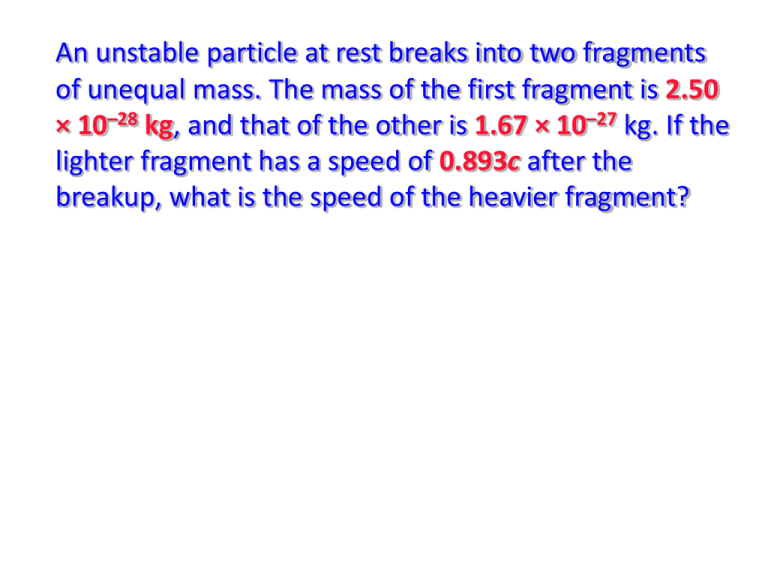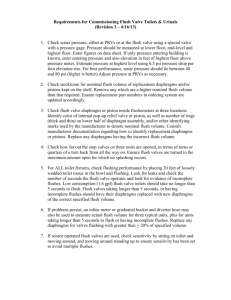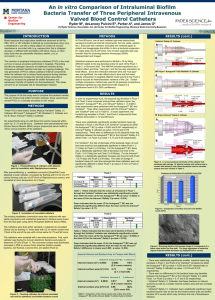Relativity 5 - UCF Physics
advertisement

An unstable particle at rest breaks into two fragments of unequal mass. The mass of the first fragment is 2.50 × 10–28 kg, and that of the other is 1.67 × 10–27 kg. If the lighter fragment has a speed of 0.893c after the breakup, what is the speed of the heavier fragment? An unstable particle at rest breaks into two fragments of unequal mass. The mass of the first fragment is 2.50 × 10–28 kg, and that of the other is 1.67 × 10–27 kg. If the lighter fragment has a speed of 0.893c after the breakup, what is the speed of the heavier fragment? Relativistic momentum of the system of fragments must be conserved. For total momentum to be zero after as it was before, we must have, with subscript 2 referring to the heavier fragment, and subscript 1 to the lighter, p2 p1 2m 2u2 1m 1u1 1.67 1027 kg u2 1 u2 c 2 2.50 1028 kg 1 0.893 2 0.893c 4.960 1028 kg c An unstable particle at rest breaks into two fragments of unequal mass. The mass of the first fragment is 2.50 × 10–28 kg, and that of the other is 1.67 × 10–27 kg. If the lighter fragment has a speed of 0.893c after the breakup, what is the speed of the heavier fragment? 27 2 1.67 10 u2 u22 1 2 28 c c 4.960 10 12.3 u22 2 c 1 u2 0.285c An unstable particle with a mass of 3.34 × 10–27 kg is initially at rest. The particle decays into two fragments that fly off along the x axis with velocity components 0.987c and –0.868c. Find the masses of the fragments. (Suggestion: Conserve both energy and momentum.) An unstable particle with a mass of 3.34 × 10–27 kg is initially at rest. The particle decays into two fragments that fly off along the x axis with velocity components 0.987c and –0.868c. Find the masses of the fragments. (Suggestion: Conserve both energy and momentum.) 1 2 1 1 0.868 2 1 1 0.987 2 2.01 6.22 E1 E2 Etotal 1m 1c2 2m 2c2 m totalc2 2.01m 1 6.22m 2 3.34 1027 kg An unstable particle with a mass of 3.34 × 10–27 kg is initially at rest. The particle decays into two fragments that fly off along the x axis with velocity components 0.987c and –0.868c. Find the masses of the fragments. (Suggestion: Conserve both energy and momentum.) 2.01m 1 6.22m 2 3.34 1027 kg This reduces to: m 1 3.09m 2 1.66 1027 kg p1 p2 1m 1u1 2m 2u2 2.01 0.868c m 1 6.22 0.987c m 2 m 1 3.52m 2 m 1 8.84 1028 kg m 2 2.51 1028 kg Suppose a heat engine is connected to two energy reservoirs, one a pool of molten aluminum (660°C) and the other a block of solid mercury (–38.9°C). The engine runs by freezing 1.00 g of aluminum and melting 15.0 g of mercury during each cycle. The heat of fusion of aluminum is 3.97 105 J/kg; the heat of fusion of mercury is 1.18 104 J/kg. What is the efficiency of this engine? Suppose a heat engine is connected to two energy reservoirs, one a pool of molten aluminum (660°C) and the other a block of solid mercury (–38.9°C). The engine runs by freezing 1.00 g of aluminum and melting 15.0 g of mercury during each cycle. The heat of fusion of aluminum is 3.97 105 J/kg; the heat of fusion of mercury is 1.18 104 J/kg. What is the efficiency of this engine? The heat to melt 15.0 g of Hg is: Q c m L f 15 103 kg 1.18 104 J kg 177 J The energy absorbed to freeze 1.00 g of aluminum is: Q h m L f 103 kg 3.97 105 J/kg 397 J and the work output is: e W eng Qh 220 J 0.554 397 J W eng Q h Q c 220 J or 55.4% 2. (a) Find the rest energy of a proton in electron volts; (b) If the total energy of a proton is three times its rest energy, what is the speed of the proton? (c) Determine the kinetic energy of the proton in electron volts. 2. (a) Find the rest energy of a proton in electron volts; (b) If the total energy of a proton is three times its rest energy, what is the speed of the proton? (c) Determine the kinetic energy of the proton in electron volts. (a)Rest energy: E0=mpc2 = (1.67 x 10-27kg) x (3 x 108m/s)2 = 1.5 x 10-10J x (1eV / 1.6 x 10-19J) = 938 MeV (b) The total energy Etot 3E0 3m p c 2 3 1 u2 1 2 c mpc2 u2 1 2 c u2 1 1 2 c 9 u2 8 2 c 9 8 u c 0.943c 2.83108 m / s 3 (c) Kinetic energy: K = Etot – E0 = 3mpc2 – mpc2 = 2mpc2 = 2 x (938 MeV) = 1876 MeV A proton in high-energy accelerator moves with a speed c/2. Use the work kinetic energy theorem to find the work required to increase the speed to (a) 0.750c and (b) 0.995c. An experimenter arranges to trigger two flashbulbs simultaneously, a blue flush located at the origin of his reference frame and a red flush at x = 30.4 km. A second observer, moving at speed 0.247c in the direction of increasing x, also views the flushes. (a) What time interval between them does she find? (b) Which flush does she say occurs first? An experimenter arranges to trigger two flashbulbs simultaneously, a blue flush located at the origin of his reference frame and a red flush at x = 30.4 km. A second observer, moving at speed 0.247c in the direction of increasing x, also views the flushes. (a) What time interval between them does she find? (b) Which flush does she say occurs first? Solution: We use Lorentz transformation equation in the “interval” form: ux t t 2 c ' First, evaluate γ: 1 u 1 c 2 1 1 0.2472 1.032 An experimenter arranges to trigger two flashbulbs simultaneously, a blue flush located at the origin of his reference frame and a red flush at x = 30.4 km. A second observer, moving at speed 0.247c in the direction of increasing x, also views the flushes. (a) What time interval between them does she find? (b) Which flush does she say occurs first? We also have: x xr xb 30.4 0 30.4km t tr tb 0 so, tr tb An experimenter arranges to trigger two flashbulbs simultaneously, a blue flush located at the origin of his reference frame and a red flush at x = 30.4 km. A second observer, moving at speed 0.247c in the direction of increasing x, also views the flushes. (a) What time interval between them does she find? (b) Which flush does she say occurs first? ux (0.247)(30.4 103 m) 5 t t 2 (1.032) 0 2 . 58 10 s 25.8s 8 c 3 10 m / s ' We got t tr tb and therefore t ' tr' tb' since Δt’< 0, we have tb > tr. Hence, the red flush is seen first. For electron : me 9.11 10 31 kg me c 2 (9.11 10 31 kg )(3 108 m / s ) 2 8.2 10 14 J 1eV 1.602 10 19 J Ee, rest mc 2 (8.2 10 14 J ) /(1.602 10 19 J / eV ) 0.511 106 eV 0.511MeV For proton: m p 1.67310 27 kg m p c 2 (1.67310 27 kg )(3 108 m / s) 2 1.511010 J E p ,rest (1.511010 J ) /(1.6021019 J / eV ) 0.938.6 109 eV 938.6MeV SUMMARY 1. Einstein’s Postulates: • Postulate 1: Absolute uniform motion can not be detected. • Postulate 2: The speed of light is independent of the motion of the source. SUMMARY • 2. The Lorentz Transformation: x' γ x ut y' y z' z xu t' γ t 2 c SUMMARY 6. The Velocity Transformation: ' vx u vx ' uv x 1 2 c v u v'x x uv 1 x 2 c SUMMARY • 3. Time Dilation: • 4. Length Contraction: • 5. The Relativistic Doppler Effect: To T u 1 c L' 2 T0 L0 cu f ' f0 cu approaching cu f ' f0 cu receding SUMMARY p 7. Relativistic Momentum: 8. Relativistic Energy: mu u2 1 2 c E m c2 K m c2 m c2 1 9. Rest Energy: 10. Kinetic Energy u2 c 2 E0 mc2 K m c2 1 u2 c 2 m c2 m c2 ( 1) SUMMARY 10. Useful Formulas for Speed, Energy, and Momentum: 2 2 E p c mc 2 E pc 2 2 for E m c u pc c E 2 • Specific Heat: • Latent Heat: Q c mT Q L m • Work done by engine: • Thermal Efficiency: Q mcT Q Lm Wengine Qnet Qh Qc Qh Qc Qc e 1 Qh Qh Qh Weng











